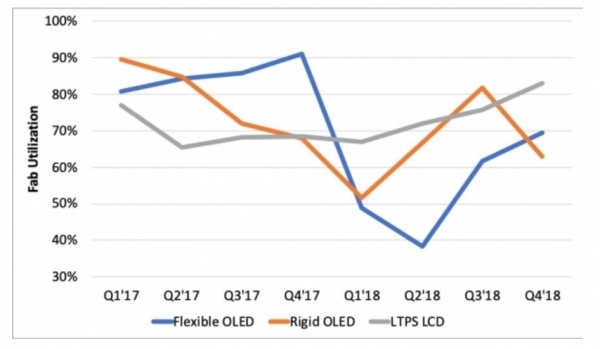
The utilization rate of the production lines for Low-Temperature Polycrystalline Silicon(LTPS) Liquid Crystal Display(LCD), the high-resolution of small and medium-sized displays, has surpassed that of Organic Light Emitting Diode (OLED). This is because the installation of LTPS LCD panels on low-cost smartphones has increased.
On the 28th, the data announced by Display Supply Chain Consultant(DSCC), a market research company, estimated the worldwide LTPS LCD panel factory utilization rate to increase from 76% in the third quarter to 83% in the fourth quarter. In the same period, the utilization rate of Rigid OLED panel factories will likely fall from 82% to 63%, while that of Flexible OLED panel factories would rise from 63% to 69%. This is the second time that LTPS LCD panel factory utilization rate has overtaken OLED, which happened in the first quarter.
The decrease in production costs due to the downscaled smartphone market has significantly influenced the recovery of LTPS LCD panel factories’ utilization rate. The industry is estimating the price of LTPS LCD panels (6 inches) to be in the low $6 range, Rigid OLED panels in the high $20 range, and Flexible OLED panels in the low $60 range.
This year, around half of the new products introduced by the top 4 Chinese smartphone companies (Huawei, Xiaomi, Oppo, and Vivo) installed LTPS LCD. Even Samsung Electronics, for which OLED had more shares, have decided to install LTPS LCD on its Galaxy A series, in addition to its Galaxy J series and Galaxy On.
Rigid and Flexible OLED panels have a high level of dependence on Samsung Display. It has a market share of 93.6% in the current year (0.43 billion units). Chinese smartphone companies shun away from a single source of supply. This is because single-source supply reduces the leeway in price negotiation. As such, Chinese companies have used various local display companies that can provide products at a relatively lower price. DSCC selected Tianma(96%), BOE(93%), and China Start(CSOT, 88%) as the top three firms with the highest level of a LTPS LCD panel utilization rate. These are all Chinese companies.
For OLED panels, the Rigid panels have a grimmer future than the Flexible ones. It looks like that the position of Flexible OLED panels is feeling the pressure among the LTPS LCD panels with competitive price levels and established market positions. Earlier, DSCC has analyzed, as the effect of new Chinese smartphones faded away, the A2 Line utilization rate of Samsung Display that produces Rigid OLED would decrease from 90% in the third quarter to 72% in the fourth quarter.
One source in the industry explained that “Samsung Display is actively promoting with functions that cannot be easily imitated by LTPS LCD, such as panel holes or installation of call speakers(receiver), in order to maintain the utilization rate of Rigid OLED factories.” The person added, “The price competition with LTPS LCD is likely to escalate even further as the Wireless Division of Samsung Electronics is experiencing supply decrease.”

